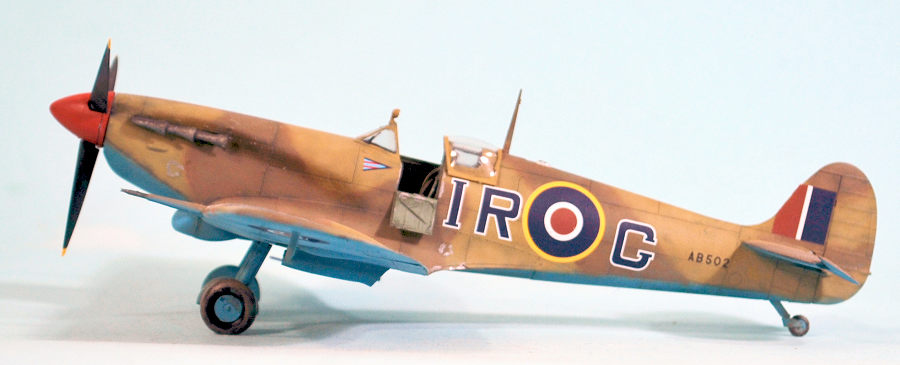
Eduard 1/48 Spitfire Vb (late)
| KIT #: | 11149 |
| PRICE: | $89.00 |
| DECALS: | Seven options |
| REVIEWER: | Tom Cleaver |
| NOTES: |

| HISTORY |
The Spitfire Vb, which began appearing in squadrons in the spring of 1941, was the most-produced Spitfire sub-type. It was a modification of the Spitfire I airframe, “beefed up” with a new engine mount, to use the Merlin 45 engine. Other than the engine, it was similar (outside of small details) to the Spitfire IIb, armed with a drum-fed Oerlikon 20mm cannon in each wing.
Ian R. Gleed in North Africa:
Ian Richard “Widge” Gleed, a doctor's son, was born in Finchley, London, on July 3, 1916. Educated at Tenterden Preparatory School and Epsom College, he learned to fly privately and flew his first solo at the London Aeroplane Club, Hatfield on November 16, 1935.
He joined the RAF on a short service commission in March 1936 and was commissioned an RAF Pilot Officer in March 1936 and posted to 46 Squadron at Kenley. 46 was flying Gauntlets at the time but transferred to Hurricanes in 1939.
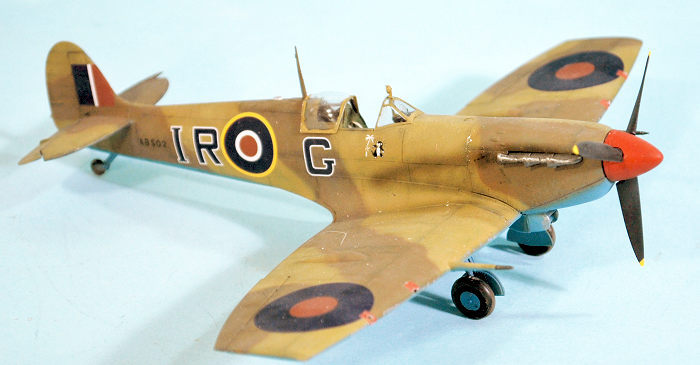 On February 18, 1940, a Spitfire was testing broke up in mid-air. He was
thrown out and lost consciousness. He came to, pulled his ripcord and the
parachute opened. He came off flying and did not return to 266 until late April
and was only allowed to fly dual. He regained full flying status on May 14,
1940.
On February 18, 1940, a Spitfire was testing broke up in mid-air. He was
thrown out and lost consciousness. He came to, pulled his ripcord and the
parachute opened. He came off flying and did not return to 266 until late April
and was only allowed to fly dual. He regained full flying status on May 14,
1940.
Gleed was was promoted to Flight Lieutenant and joined 87 Squadron in France May 17, 1940. Between May 17-20, he scored 5 victories plus a share in another and 1 probable. 87 Squadron returned to England on May 20 to re-form and re-equip. On August 1, Gleed became the squadron leader. On August 15, he led the squadron into a large German formation and shot down two Bf-109s and a possible third. He scored 4 more before the end of the Battle of Britain and was awarded the Distinguished Flying Cross and later the Distinguished Service Order. He then led 87 in developing night fighting and night intruder tactics in the Hurricane.
He was appointed Wing Leader at Middle Wallop on November 18 and led the wing in the “lean into France” in the spring of 1941, finally coming off tour on July 16 and assigned to Fighter Command as Wing Commander Tactics, becoming Wing Commander Operations on December 7, 1942.
Gleed was sent to North Africa in January 1943, where he flew briefly with 145 Squadron for operational experience, then led 244 Wing through the fighting in Libya and into Tunisia.
On an afternoon patrol on April 16, 1943, he led an attack on a formation of Ju-52 transports over Cape Bon, escorted by Bf-109s. During the fight, he was shot down, probably by Leutnant Reinert of JG 77.
After being hit, Gleed headed for the Tunisian coast. His Spitfire, AB502, was found on sand dunes near the sea on the western coastline of Cap Bon. His body was not found there but was found buried at Tazoghrane. He was reburied in the Military Cemetery at Enfidaville on April 25, 1944.
| THE KIT |
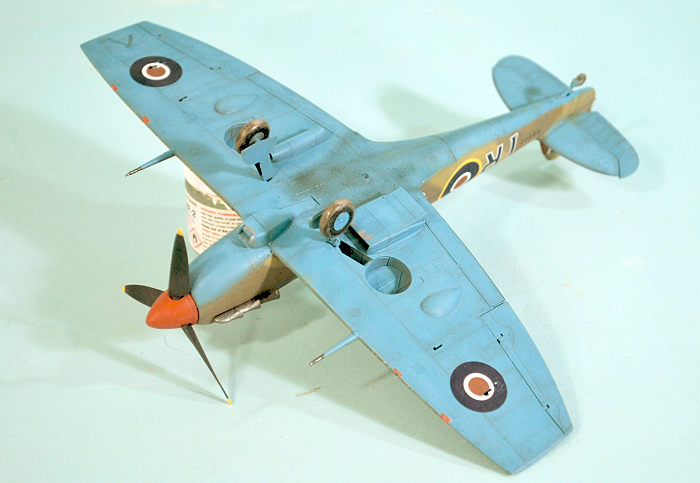 This Spitfire Vb (Late) is the other option in the dual combo limited
release “Eagles Call” kit. It is a “late” Spitfire Vb in that the fuselage is
molded to take the later windscreen with the internally-mounted armor glass
windscreen. The lower wing has the correct fairing for the cannon drum for the
Spitfire Vb, which differs from that of the Spitfire IIb.
This Spitfire Vb (Late) is the other option in the dual combo limited
release “Eagles Call” kit. It is a “late” Spitfire Vb in that the fuselage is
molded to take the later windscreen with the internally-mounted armor glass
windscreen. The lower wing has the correct fairing for the cannon drum for the
Spitfire Vb, which differs from that of the Spitfire IIb.
I opted to do this as Ian R. Gleed’s AB502, since I had the decals for it on “Spitfire: Aces of the Empire” and the kit provided the correct Aboukir filter for this airplane.
| CONSTRUCTION |
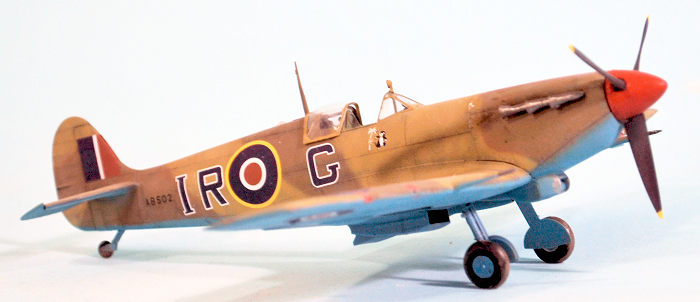 If you follow the instructions and take your time, you will be rewarded
with a really nice model. There are parts in this release for all Spitfire Vb
sub-types, with both the Vokes and two types of Aboukir filters present.
If you follow the instructions and take your time, you will be rewarded
with a really nice model. There are parts in this release for all Spitfire Vb
sub-types, with both the Vokes and two types of Aboukir filters present.
I opted to assemble this kit by changing the method of attaching the wing. After assembling the gear well parts in the lower wing, I attached the lower wing to the completed fuselage, then attached the upper wing parts. I was able to get a nice tight fit without all the “pushing and shoving” one goes through if you assemble the wing sub-assembly completely and then mate it to the fuselage sub-assembly. I will be doing this always on all future Eduard Spitfires (and there will be more - these are great kits).
I used the Aboukir filter option that has the sharp angle in the lower nose panel that is correct for Gleed’s airplane.
| COLORS & MARKINGS |
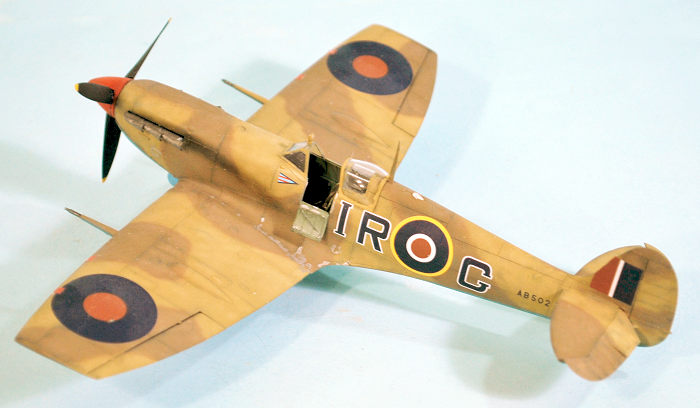 Gleed’s AB502 had a repaint at the Aboukir depot, which is an
“approximation” of the “B” scheme. I had done this airplane before with the
Hasegawa limited release 25 years ago, which had a detailed three-view painting
diagram for AB502, and had taken photos from all angles of the completed model,
which I referred to in painting this model. I used my mixtures for Tamiya paint
to do Dark Earth, Middle Stone and Azure Blue, applied freehand with my Paasche-H
using a No. 1 fine tip. I went back over each upper surface color three times,
adding in first a bit of light grey, then a bit of yellow, and then white, to
simulate sun-fading under the hot North African sun.
Gleed’s AB502 had a repaint at the Aboukir depot, which is an
“approximation” of the “B” scheme. I had done this airplane before with the
Hasegawa limited release 25 years ago, which had a detailed three-view painting
diagram for AB502, and had taken photos from all angles of the completed model,
which I referred to in painting this model. I used my mixtures for Tamiya paint
to do Dark Earth, Middle Stone and Azure Blue, applied freehand with my Paasche-H
using a No. 1 fine tip. I went back over each upper surface color three times,
adding in first a bit of light grey, then a bit of yellow, and then white, to
simulate sun-fading under the hot North African sun.
I used the kit decals for the national markings, and the decals in “Spitfire: Aces of the Empire” for the individual markings. This sheet has Figaro the cat, which Gleed used as his personal symbol, tearing down an Afrika Korps palm tree, which is correct for AB502.
I gave the model several coats of clear flat varnish to get that “sun bleached” final finish, then applied exhaust staining as shown in photos of the airplane and added a few “dings” with Vallejo “Dull Aluminum.” I unmasked the canopy and posed it open, attached the landing gear and the Rotol prop.
| CONCLUSIONS |
This kit is, again, “the best of its sub-type in 1/48 scale” as are all the Eduard Spitfires. Changing the method of wing assembly made things far easier, while getting a better final result. I recommend that assembly sequence to you. You’ll like it. There are a bazillion decal options for Spitfire Vbs in aftermarket decals, and I know this won’t be the only model I build with this great kit.
7 October
Thanks to Eduard for the review kit. If you would like your product reviewed fairly and fairly
quickly, please
contact
the editor
or see other details in the
Note to
Contributors.